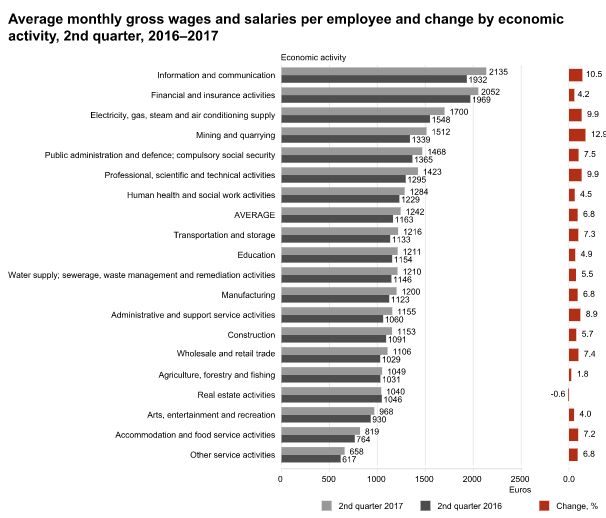Analytics, Estonia, Financial Services, Markets and Companies, Wages
International Internet Magazine. Baltic States news & analytics
Friday, 26.12.2025, 23:09
In Q2, gross wages in Estonia grew to 1,242 euros
 Print version
Print versionThe average monthly gross wages and salaries were
1,120 euros in April, 1,201 euros in May and 1,311 euros in June. The monthly
gross wages and salaries in June were higher mainly due to an increase in
irregular bonuses and premiums and holiday pay. Compared to the previous
quarter, the average monthly gross wages and salaries increased 7.7%.
In the 2nd quarter of 2017, irregular bonuses and
premiums increased 7.1% per employee compared to the 2nd quarter of 2016 and
remained relatively constant in comparison with the last quarter. Without
irregular bonuses and premiums, the average monthly gross wages and salaries
increased as much as with irregular bonuses and premiums (6.8%).
Real wages, which take into account the influence of
the change in the consumer price index, increased slower compared to the 2nd
quarter of 2016 than the average monthly gross wages and salaries due to an
increase in consumer prices. Compared to the 2nd quarter of 2016, real wages
rose 3.7%. Real wages have been increasing year-over-year since the second half
of 2011.
The average hourly gross wages and salaries were 7.50
euros in the 2nd quarter of 2017, and the increase was 8.5% compared to the 2nd
quarter of the previous year.
The average monthly gross wages and salaries continued to be the highest in information and communication and in financial and insurance activities, respectively 2,135 and 2,052 euros.
Compared to the 2nd
quarter of 2016, the average monthly gross wages and salaries increased the
most in mining and quarrying (12.9%), information and communication (10.5%),
electricity, gas, steam and air conditioning supply (9.9%) and in professional,
scientific and technical activities (9.9%). Compared to the 2nd quarter of
2016, average monthly gross wages and salaries remained relatively constant in
real estate activities (-0.6%) and in agriculture, forestry and fishing (1.8%).

In the 2nd quarter of 2017, the year-over-year growth
in average monthly gross wages and salaries was faster in foreign private
sector enterprises (8.8%) and in state organisations and enterprises (7.9%) and
slower in local government organisations (6.7%) and in Estonian private sector
enterprises (5.8%).
In the 2nd quarter of 2017, by county, the average
monthly gross wages and salaries were the highest in Harju (1,372 euros) and
Tartu (1,227 euros) counties and the lowest in Hiiu (869 euros) and Saare (884
euros) counties. The year-over-year growth of average monthly gross wages and
salaries was the fastest in Ida-Viru (14%), Rapla (11%) and Võru (9%) counties.
The average monthly gross wages and salaries fell in Saare (3%) and Hiiu (7%)
counties.
According to the Wages and Salaries Statistics Survey,
the number of employees converted to full-time equivalent units decreased 0.3%
compared to the previous quarter and increased 3.5% compared to the 2nd quarter
of 2016. The biggest year-over-year increase in the number of employees in
full-time equivalent units occurred in administrative and support service
activities (15%), agriculture, forestry and fishing (15%) and in information
and communication (14%), and the biggest year-over-year decrease occurred in
transportation and storage (8%), public administration and defence; compulsory
social security (3%) and in professional, scientific and technical activities
(3%). Over the course of a year, the number of employees converted to full-time
equivalent units increased 5% in the private sector and decreased 1% in the
public sector.
In the 2nd quarter of 2017, the average monthly labour
costs per employee were 1,673 euros and the hourly labour costs were 11.17
euros. Compared to the 2nd quarter of 2016, the average monthly labour costs
per employee increased 6.7%.
Average monthly gross wages and salaries per employee and change, 1st quarter 2015–2nd quarter 2017
|
Year |
Quarter |
Average monthly gross wages |
Change compared to the same |
|
2015 |
I |
1,010 |
4.5 |
|
II |
1,082 |
5.8 |
|
|
III |
1,045 |
6.9 |
|
|
IV |
1,105 |
6.4 |
|
|
2016 |
I |
1,091 |
8.1 |
|
II |
1,163 |
7.6 |
|
|
III |
1,119 |
7.1 |
|
|
IV |
1,182 |
6.9 |
|
|
2017 |
I |
1,153 |
5.7 |
|
II |
1,242 |
6.8 |
Statistics Estonia conducts the Wages and Salaries
Statistics Survey on the basis of an international methodology since 1992. In
2017, the sample includes 12,315 enterprises, institutions and organisations.
The average monthly gross wages and salaries have been given in full-time units
to enable a comparison of wages and salaries irrespective of the length of
working time. Calculations of the monthly gross wages and salaries are based on
payments for time actually worked and remuneration for time not worked. The
hourly gross wages and salaries do not include remuneration for time not worked
(holiday pay, benefits, etc.). In short-term statistics, the average gross
wages and salaries are measured as a component of labour costs. Labour costs
include gross wages and salaries, employer’s contributions and employer’s
imputed social contributions to employees.
The statistics are based on the questionnaire “Wages
and salaries”, the deadline of which was 18 July 2017. Statistics Estonia
published the quarterly summary in 31 working days. For the statistical
activity “Wages and salaries”, the main representative of public interest is
the Ministry of Economic Affairs and Communications, commissioned by whom
Statistics Estonia collects and analyses the data necessary for conducting the
statistical activity.








 «The Baltic Course» Is Sold and Stays in Business!
«The Baltic Course» Is Sold and Stays in Business!

